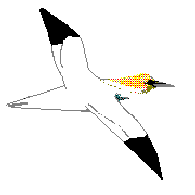Llandulas, Pensarn and Abergele
From Autumn to Spring and particularly in strong North-North Westerly winds, a walk along the beach from any of these places should bring some reward. Some waders can be found on the shoreline, including Redshank, Turnstone, Curlew and Dunlin, while close to shore, it is possible to see Red Throated Divers, Scaup, Common and Velvet Scoters, Eider Duck and some Auks. In Abergele, Pentremawr Park Lake can produce some interesting birds. Apart from the swans, ducks, geese and gulls that roost here, Mediterranean, Glaucous and Iceland Gulls are recorded in some years.
Colwyn and Penrhyn Bays
Most of what has been said in the previous paragraph applies here. Sea watching is good all along
these beaches but perhaps the most favoured place is from Rhos Point (SH842810). Autumn is good
especially when gales blow Artic Skuas, Manx Shearwater and Leach's Petrel Close to Shore.Rhyl and Clwyd Estuary
Rhyl seafront in Autumn/Winter is essentially similar in most respects to the previous entries
on seawatching. At the west end of Rhyl the River Clwyd drains into the Irish Sea. There is
good access to the estuary with footpaths either side. The species likely to be encountered
here are the same as those on the Upper Dee Estuary.
Conwy Estuary (RSPB)
Opened in Spring 1995 this newest of RSPB reserves is still in the process of construction.
Access is gained by taking the Conwy turnoff on the A55 at Llandudno Junction. At the next
roundabout, take the first left (signposted RSPB Conwy) onto the reserve. Admission is free
in the first year, otherwise a small fee is levied to none RSPB members. The reserve consists
of a number of freshwater lakes and ponds with good scrub between, and saltwater marsh and
intertidal mud flats. The lakes which are newly created are already attracting a good
selection of ducks and waders, while the scrub holds Grey, Pied and Yellow Wagtails, Skylark and
Pipits. The dense bramble and trees on the northern edge has Whitethroat and Lesser Whitethroat.
Heron, Cormorants, Shelduck, Curlew, Whimbrel, Oystercatchers and Gulls are amongst the many
birds that can be seen in the estuary. Amongst the uncommon birds that have been reported
since the opening are Marsh Harrier and Garganey.
Frodsham Marshes
Frodsham Marsh lies in the Mersey Estuary northwest of Frodsham town. Access to the marsh can be
gained, coming from Clwyd, by turning left between Helsby and Frodsham, on the A56 at Godscroft
Lane, just after Godscroft School. A 1Km down the lane turn left over a bridge which
crosses the M56 onto Frodsham Marshes.The marsh is owned by The Manchester Ship Canal Company
and comprises a number of large shallow Lakes and areas of marshland. At the east end of the
marsh, the River Weaver flows into the Mersey at Runcorn. This is an exceptional area for
birdwatchers all year round.
 Coastal
Coastal